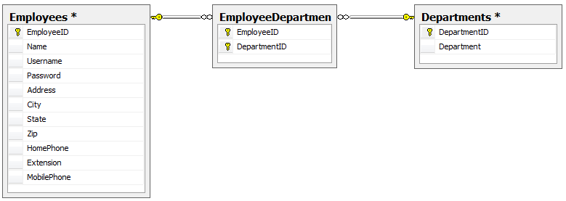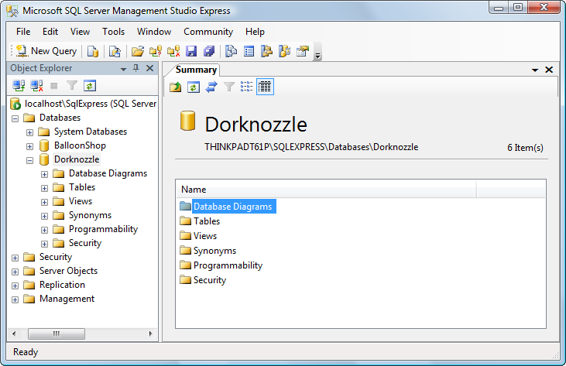Build Your Own ASP.NET 3.5 Website Using C# & VB (56 page)
Read Build Your Own ASP.NET 3.5 Website Using C# & VB Online
Authors: Cristian Darie,Zak Ruvalcaba,Wyatt Barnett
Tags: #C♯ (Computer program language), #Active server pages, #Programming Languages, #C#, #Web Page Design, #Computers, #Web site development, #internet programming, #General, #C? (Computer program language), #Internet, #Visual BASIC, #Microsoft Visual BASIC, #Application Development, #Microsoft .NET Framework



Database Design and Development
303
Figure 7.28. The properties of a foreign key
Advanced Foreign Key Options
Unless you really know what you’re doing, we recommend that you use the default
foreign key options for now. However, it’s good to have some idea of the features
available through the Properties window, as they may well come in handy later
in your database development career.
The most significant setting here is
Enforce Foreign Key Constraint
, which, when set
to
Yes
, prevents users or applications from entering inconsistent data into our
database (for example, by inserting into the Employees table a DepartmentID value
that doesn’t have a matching entry in the Departments table). In our application,
every user must be associated with a valid department, so we’ll leave this option
enabled.
The options available under
INSERT And UPDATE Specification
can be used to tell your
database to update the tables itself in order to keep the data valid at times when a
change in a given table would affect a related table. If, for some reason, we changed
the ID of a department in the Departments table, we could set the database to
propagate this change to all the tables related to that department, keeping the relationships intact. Similarly, we can set the database to automatically delete all the employees related to a department that’s deleted. However, these are quite sensitive
options, and it’s best to avoid them unless you have good reason not to. The cases
in which an ID changes are very uncommon (the ID doesn’t have any special
meaning itself, other than being an unique identifier), and letting the database delete
data for you is a risky approach (it’s safer to delete the related records yourself).
Licensed to [email protected]

304
Build Your Own ASP.NET 3.5 Web Site Using C# & VB
If these concepts sound a bit advanced at the moment, don’t worry: it will all become
clear as you spend some time working with databases.
Many-to-many Relationships
Many-to-many relationships occur between two tables, when records from either
table can be associated with multiple records in the other table.
Imagine that you wanted a single employee to be able to belong to more than one
department—someone who works in “Engineering” could also be an “Executive,”
for example.
One
employee can belong to
many
departments, and
one
department can contain
many
employees, so this is a many-to-many relationship.
How do we represent it in our database? Faced with this question, many less-experienced developers begin to think of ways to store several values in a single column, because the obvious solution is to change the DepartmentID column in the Employees
table so that it contains a list of the IDs of those departments to which each employee
belongs. One those good old rules of thumb we discussed previously applies here:
If you need to store multiple values in a single column, your design is probably
flawed.
The correct way to represent a many-to-many relationship is to add a third table,
named a
mapping table
, to the database. A mapping table is a table that contains
no data other than the definitions of the pairs of entries that are related.
Figure 7.29
shows the database design for our employees and departments.
Figure 7.29. Using a mapping table to implement a many-to-many relationship
Licensed to [email protected]
Database Design and Development
305
The EmployeeDepartment table associates employee IDs with department IDs. If we
added this table to our database, we could add Zak Ruvalcaba to both the “Executive”
and “Engineering” departments.
A mapping table is created in much the same way as any other table. The only difference lies in the choice of the primary key. Every table we’ve created so far has had a column named
something
ID that was designed to be that table’s primary key.
Designating a column as a primary key tells the database not to allow two entries
in that column to have the same value. It also speeds up database searches based
on that column.
In the case of a mapping table, there’s no single column that we want to force to
have unique values. Each employee ID may appear more than once, as an employee
may belong to more than one department, and each department ID may appear more
than once, as a department may contain many employees. What we
don’t
want to
allow is the same
pair
of values to appear in the table twice (it wouldn’t make sense to associate a particular employee with a particular department more than once).
For this reason, we usually create mapping tables with a multi-column primary key.
In this example, the primary key for the EmployeeDepartment table would consist
of the EmployeeID and DepartmentID columns. This enforces the uniqueness that
is appropriate to a look-up table, and prevents a particular employee from being
assigned to a particular department more than once.
If you’d like to learn more about many-to-many relationships, or about anything
else related to SQL Server programming, I recommend you download and use the
product’s excellent documentation,
SQL Server Books Online.3
Summary
This chapter has introduced the fundamental concepts of relational databases. You
learned about the underlying structure of a modern relational database, which is
composed of tables, columns, and rows, and about crucial concepts that can aid in
database performance, maintenance, and efficiency. You’ve also learned how to
implement and enforce table relationships, and you have a solid understanding of
good relational database design.
3 http://msdn2.microsoft.com/en-us/library/ms130214.aspx
Licensed to [email protected]
306
Build Your Own ASP.NET 3.5 Web Site Using C# & VB
Chapter 8 goes beyond data storage and introduces you to the language used to access
and manipulate the data you hold in your tables. That language is the Structured
Query Language, or SQL.
Licensed to [email protected]
Speaking SQL
So your database has been created, and you’ve defined all of the tables you’ll need,
and all of the columns for your tables—you’ve even defined the relationships
between your tables. The question now is, “How will you get to that data?” Sure,
you can open the database, look at the data contained in the tables, and manually
insert and delete records, but that does little to help your web users to interact with
that data. Mary in Accounting isn’t going to want to download and learn to use SQL
Server Management Studio just so she can retrieve an employee’s mobile phone
number—this functionality has to be provided by the Dorknozzle intranet web site,
which, after all, is supposed to enable staff members to access data easily. In fact,
the functionality can be created using web forms, web controls, a little code, and a
useful database programming language known as Structured Query Language (or
SQL).
SQL has its origins in a language developed by IBM in the 1970s called SEQUEL
(which stood for Structured English QUEry Language), and is still often referred to
as “sequel” or “ess-que-el.” It represents a very powerful way of interacting with
current database technologies and the tables that constitute our databases. SQL has
roughly 30 keywords and is the language of choice for simple and complex database
Licensed to [email protected]
308
Build Your Own ASP.NET 3.5 Web Site Using C# & VB
operations alike. The queries you’ll construct with these keywords range from the
very simple to extremely complex strings of subqueries and table joins.
SQL is an international standard, and almost all database products, including SQL
Server, Oracle, DB2, and so on, support the standard to a certain degree. The dialect
of SQL supported by SQL Server is named Transact-SQL (or T-SQL). This chapter
cannot begin to cover all there is to know on the subject, but we hope it will provide
you with an introduction to beginning and advanced SQL concepts.
In this chapter, you’ll learn:
■ the basic SQL commands
■ the expressions that SQL supports
■ the most important SQL functions
■ how to perform table joins and subqueries
■ how to create stored procedures
This may sound like a lot of work, but you’re certain to enjoy it! Let’s get started.
Reading Data from a Single Table
Information that’s contained within a database is useless unless we have a way to
extract it. SQL is that mechanism; it allows quick but sophisticated access to database
data through the use of
queries
. Queries pose questions to the database server, which
returns the answer to your application.
Table 8.1. Sample contents from the Employees table
EmployeeID
Dep'tID
Name
Username
City
(Primary Key)
1
5
Zak Ruvalcaba
zak
San Diego
2
9
Jessica Ruvalcaba
jessica
San Diego
3
6
Ted Lindsey
ted
San Diego
4
6
Shane Weebe
shane
San Diego
5
9
David Levinson
david
San Diego
6
1
Geoff Kim
geoff
San Diego
Licensed to [email protected]

